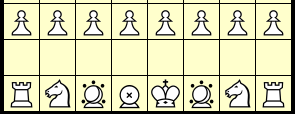Comments/Ratings for a Single Item
This looks much better!
Aside: With the name, I was rather expecting to see something featuring Camelriders. Don't change the name; it's fine -- but maybe someone can do something like that with Zebrariders. :)
In my opinion game is beautiful, its name is awful. Please change it, maybe just slightly. Maybe even deleting a space between C and T will work for me.
I think that's a matter of taste!
I find ZZ Top and CC Top funny. Anyway, you remember them, don't you? The main thing is that the game fits. I'm pleased that you like it :-) .
 Bn Em wrote on Mon, Jun 17, 2024 07:51 PM EDT:
Bn Em wrote on Mon, Jun 17, 2024 07:51 PM EDT:The reference to pieces being ‘bound’ to columns remains in the Rules section; it's more‐or‐less clear from context what you mean but since that word has an established technical meaning (being unable to leave a region as a consequence of one's move, as of e.g. a Bishop) it'd be clearer to avoid it entirely. In any case that sentence adds little more than linking with the name; ‘associated with’ would be quite clear.
It would probably be clearer to fold the statement about the e file into the subsection about Ranks 3–7 as another bullet point, rather than giving it a separate subs'n. Which would also allow you to get rid of the exception notice
 H. G. Muller wrote on Tue, Jun 18, 2024 12:49 AM EDT:
H. G. Muller wrote on Tue, Jun 18, 2024 12:49 AM EDT:It doesn't say whether the King is exempted from morphing, or whether a resulting piece would stay royal if it does.
Note that a piece that moves as the piece in the FIDE setup that started on the file it is currently on is known as a Querquisite, and that the pieces used here are very much related to this. So it might be good to refer to this, for better historical context.
This is basically just a sub-variant of Avatar Chess on a 9x9 board, with different, more regular assignment of the morph targets to the squares. The only 'novelty' is that there are now also some squares where pieces don't morph.
And what is the point of including three basically identical diagrams? I would suggest reducing this to a single one.
... it's more‐or‐less clear from context what you mean but since that word has an established technical meaning (being unable to leave a region as a consequence of one's move, as of e.g. a Bishop) it'd be clearer to avoid it entirely.
You go much deeper into the details than I am allowed to. I am interested in the idea and perhaps a little less in the formulation of the description.
I'd like to adapt to you, but I'm afraid that we'll end up in discussions like we had with 'Morphomania'.
The game was played in 'Game Courier' without any problems. From this I conclude that the other players have understood the game. That's what it should be - right?
Of course, serious errors should be eliminated.
 H. G. Muller wrote on Wed, Jun 19, 2024 02:50 AM EDT in reply to Gerd Degens from Tue Jun 18 11:28 AM:
H. G. Muller wrote on Wed, Jun 19, 2024 02:50 AM EDT in reply to Gerd Degens from Tue Jun 18 11:28 AM:I am interested in the idea and perhaps a little less in the formulation of the description.
But what people will see here is the description, and not your ideas. It is the task of editors to make sure the presentation is concise and clear.
Your description is plain wrong: pieces are not bound to columns at all; each piece can reach the entire board. It is just that they move differently in different files (which is the usual English Chess jargon for what you call 'columns'). And even that is not strictly true, as there are Pawn moves in all files, and on 1st and 9th rank every type can be anywhere.
It is also not clear whether a piece morphed into a Pawn on 2nd rank has a double move. The Interactive Diagram doesn't grant one.
The description is also ambiguous as to whether castling is allowed; 'takes place' seems wrong wording for being allowed anyway. Whether it will take place depends on the players.
Note that a piece that moves as the piece in the FIDE setup that started on the file it is currently on is known as a Querquisite, and that the pieces used here are very much related to this. So it might be good to refer to this, for better historical context.
You show once again that you understand much more about chess and its historical context. 'Querquisite' means nothing to me. If you had a formula to establish the historical context, I would be grateful.
This is basically just a sub-variant of Avatar Chess on a 9x9 board, with different, more regular assignment of the morph targets to the squares. The only 'novelty' is that there are now also some squares where pieces don't morph.
You might be right. Avatar Chess can be seen as a top variant in terms of morphing. Then all other variations that deal with morphing are sub-variants. And all the squares that are not morphed are an 'novelty' compared to Avatar Chess.
But we are dealing with variations that offer move variations that deviate from standard chess.
In addition, all variants that deal with morphing would be superfluous - provided the benchmark is Avatar Chess. That would be nice.
That's why variants with different morphing activities have their raison d'être - at least in my opinion.
I have tried to clarify the description.
11 comments displayed
Permalink to the exact comments currently displayed.

Two points of detail:
Otherwise this looks to be a fun game!